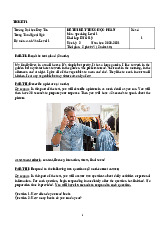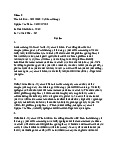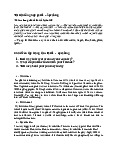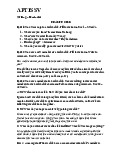



















Preview text:
ĐẠI HỌC DUY TÂN Khoa: Ngoại ngữ
Bộ môn: Anh văn Tổng quát
Giảng viên: Trần Thị Thúy Ngân TẬP BÀI GIẢNG
Môn học: Writing – Level 1 Mã môn học: ENG117
Số tín chỉ: 1 (Lý thuyết: 1; Thực hành: 0)
Dành cho sinh viên ngành/lớp:
Bậc đào tạo: Đại học Học kỳ 1 Năm học 2020 - 2021 0 THỜI
NỘI DUNG VÀ SỐ GIỜ GIAN Bài giảng Kiểm tra CHÚ Tuần THÍCH SPEAKING LEVEL 1 Số Số Nội NộI DUNG giờ giờ dung 22 Chapter I: Read A Text Aloud 1
LESSON 1: INTRODUTION ENGLISH SOUNDS 24 2 LESSON 2: TROUBLESOME SOUNDS 25 3 LESSON 3: PRACTICE FOR PART 1 CHAPTER II: DESCRIBE A PICTURE 26 4 LESSON 4: INTRODUCTION PART 2 27 5
LESSON 5: HOW TO DESCRIBE A PICTURE
LESSON 6: COMMON EXPRESSIONS USED
TO INTRODUCE PICTURE DESCRIPTION 28 6 AND PRACTICE
CHAPTER III: RESPOND TO QUESTION 29 7
LESSON 7: INTRODUCTION TO PART 3 AND QUESTION TYPES 30 8
LESSON 8: TYPE TOPICS FOR PART 3
LESSON 9: PRACTICE FOR RESPONDING TO 31 9 QUESTIONS
CHAPTER IV: RESPOND TO QUESTION USING INFORMATION PROVIDED 32 10
LESSON 10: INTRODUCTION FOR PART 4 1 LESSON 11: TIPS AND TASKS FOR 33 11 ANSWERING EFFECTIVELY 34 12 LESSON 12: PRACTICE FOR PART 4 34 13 LESSON 13: MODET TEST 1 36 14 LESSON 14: MODEL TEST 2
PART I: READ A TEXT ALOUD
LESSON 1: INTRODUCTION TO TOEIC SPEAKING, PART 1 & ENGLISH SOUND I. INTRODUCTION: A. Content:
Introduction about reading a text aloud B. Approach: Communicative Approach. C. Objectives:
At the end of the chapter, students will able to:
Know vowels, consonants, plurals in sentences
Say aloud vowels, consonants and plurals in sentences
Practice vowels, consonants and plurals in sentence
Improve speaking skills and pronunciation.
Introduce the test form of reading a text aloud. Know some tips in the test. D. Teaching aids: Projector. Laptop. Handouts. Book. Workbook. Board, chalk, or marker. E. Teaching procedure:
Possible topics may include:
» Advertisements, announcements, and news broadcasts 2
» Tour information, traffic reports, and weather reports
» Entertainment, health, housing, shopping, and travel QUICK GUIDE: Read a Text Aloud Definition
Questions 1 and 2 test your ability to pronounce words
clearly and speak English in a comprehensible way. You
will read a short text aloud, and your reading of the text will be recorded for scoring. Targeted Skills
In order to do well on Questions 1 and 2, you must be able to:
• pronounce common words correctly.
• use correct intonation when reading sentences.
• use correct stress on syllables and words. Text Types A good response will:
• reflect an accurate pronunciation of the words.
• contain smooth connections between words.
• contain accurate phrasing of groups of words and “chunks” of language.
• include correct stress for emphasis, new information, and contrast.
• include appropriate intonation to indicate the attitude or tone of the text. Things to Remember
1. Scan the entire text before reading so you have an idea of the content.
2. Read clearly and in a voice that can be easily heard.
3. Remember to pause for commas and periods.
4. Be sure to use intonation that matches the meaning of the sentences.
5. Be careful to pronounce the words correctly.
II. INTRODUCTION TO ENGLISH SOUND 1. VOWELS: - Short vowels - Long vowels - Dipthongs 3 EXAMPLE [i:] be, eve, see, [i] it, kiss, tip, [e] let, tell, meal, read, system, busy bread, dead [ei] aim, wait, [æ] cat, apple, [a:] army, car, eight, weight, last, class father, calm [ai] ice, find, my, [au] out, about, [o] not, rock, style now, brown more, order [o:] saw,bought, [oi] oil, voice, [ou] go, note, law, thought noise, boy open 2. CONSONANTS EXAMPLE 4 III. Practice:
Identify the vowels and consonants in the following words and phrases
- T divides the class into two groups.
- T asks each groups find and underline consonants in the following sentences.
- The group which finishes first will win, 1. 5 2. 3. A. 6 B. 1. have an open book 17. relaxing by the river 2. paying the cashier 18. taking a break 3. using a pay phone 19. watering the plant 4. using a public phone 20. weighing the luggage 5. performing outdoors 21. working on the computer
6. reaching to pick up the tools 22. working on the farm 7. picking some flowers
23. sitting in alternate seats 8. walking along the pier 24. hanging on the wall 9. pointing at the document 25. hanging from the ceiling
10. pouring water for the customer 26. is at the intersection 11. using a projector 27. lined up on the shelf
12. putting fuel in the vehicle 28. lying on the ground 13. raking the leaves 29. overlook the water
14. reaching for something on the shelf 30. are partially shaded 15. rearranging the furniture 31. arranged in the patio
16. looking at her reflection in the mirror
32. piled up on the steps of the houses HOMEWORK:
- T asks Ss to practice plurals at home - Prepare new lesson
LESSON 2: SOME COMMON TROUBLESOME SOUNDS,
WORD STRESS AND INTONATION Time: 60 minutes
A. Content: Some common troubles some sounds, word stress and intonation. B. Approach: Communicative Approach. C. Objectives:
At the end of the lesson, students will able to: 7 Pronunciate in English
Know some common troubles some sounds, word stress and intonation in English. Practice pronunciation.
know when to use formal or informal greetings.
improve speaking and pronunciation skills. D. Teaching aids: Projector. Laptop. Handouts. Book. Workbook. Board, chalk, or marker. E. Teaching procedure: I/ Lead-in: (5 mins)
- T shows common troubles some sounds, word stress and intonation.
Ss answer and T leads in the new lesson. II/ Content:
- T shows the list of common troubles some sounds, word stress and intonation.
- T divides the class into four groups.
- After ten minutes, T invites all groups present before the class.
* SOME COMMON TROUBLESOME SOUNDS: 1. short /i/ and / æ/ Ban can dan fan jan pan tan Bin kin din fin gin pin tin 2. /f/ and /v/ Fat fete fan life leaf fife Vat vet van live leave five 3. / / Asian closure collision decision diversion division Erosion immersion intrusion lesion measure pleasure Television treasury version vision visual 8 [t] vs[θ] [t] Tree Team Tie Taught [θ] Three Theme Thigh Thought [θ] vs [s] [s] Face Worse Gross Sick [θ] Faith Worth Growth Thick [l] vs [r] [l] Long Walking Light Late [r] Wrong Working Right Rate [b] vs [v] [b] Belly Boat Best Ban [v] Valley Vote Vest Van [p] vs [f] [p] Pan Peel Pork Pink [f] Fan Feel Fork Fine [e] vs [æ] [e] Men Left Said Pen [æ] Man Laughed Sad Pan [i] vs [i:] [i] Ship Fill Live Hill [i:] Sheep Feel Leave Heel [o:] vs [ou] [o:] Hall Saw Walk Called [ou] Hole Sew Woke Cold WORD STRESS
Stress is important in words and sentences. Knowing whether a syllable is stressed or
unstressed is an important part of pronouncing a word correctly. For example, re-CORD and
REC-ord have two very different meanings, but they have the same spelling, record.
Correctly stressing words and phrases gives rhythm to a sentence, and it signals the
importance of some information.
» TIP 1 Learn stress in order to pronounce words correctly.
All words with more than one syllable have stressed and unstressed syllables. Knowing
which syllables are stressed will help you pronounce words correctly and convey the correct meaning.
In nouns and adjectives with two syllables, the stress usually falls on the first syllable. For
verbs with two syllables, the stress usually falls on the second syllable. Listen and read the words in the chart. 9
TASK 1 Look at the words and analyze the suffixes. Underline the syllables that you think are stressed.
Knowing prefixes (the small parts that come before the root of the word) can also help you
predict the stress pattern of a word. When the word is a verb or has more than two syllables,
the stress is usually on the second syllable of the word. Here are examples of some common prefixes.
TASK 2 Look at the words and analyze the prefixes. Underline the syllables that you think are stressed. 10 TASK 3 boldfaced
Read the sentences and notice the
words. Circle the boldfaced words that
are nouns, and underline the boldfaced words that are verbs. Then double-underline CJ the
>>TIP 2 Stress words in sentences to emphasize or contrast information.
Use stress within a sentence to show that certain information is new or important. You
can also use stress to contrast information.
A: Would you like some tea?
B: I ’d like some black (1) tea.
A: Sure, here you are.
B: Sorry, but this is green (2) tea. I asked fo r black (2) tea.
You should also use stress to give more emphasis to the words that naturally carry meaning in
sentences— the content words. Function words, or the words in a sentence that are used to
give grammatical structure, don’t usually receive as much stress unless the speaker wants to
give some sort of contrast or emphasis.
The employees are the ones to thank.
There’s really not a lot to about that. say
Finally, adverbs are frequently stressed to add emphasis.
We really don’t have much time.
I completely forgot the conference.
TASK 1. Underline the words that receive stress on the first syllable.
1. The correct numbers are 13 and 17, not 30 and 70.
2. We strongly suggest that you back up your computer files at the end of the day.
3. Our genealogists will conduct a very thorough search of your family tree.
4. On the new schedule, you will see that the bus departs on Tuesday at 1 p.m.
5. Your estimated wait time to speak to a representative is ten minutes.
6. The parking spaces are clearly marked “visitor.”
TASK 2 Read the sentences. Which boldfaced words do you think should be stressed? Underline your choices.
1. The real estate office is located in the green house on the left.
2. You will receive a credit card within after receipt ten days your applic of ation.
3. The message said to phone their office between 9 Monday to Friday and 5, .
4. We are currently reviewing your request and will respond within 30 days. 5. turn down Please
the volume on the TV, not up. * INTONATION: 11 I/ Intonation:
Sentence intonation helps the listener understand the speaker’s meaning, in addition to
the speaker’s attitude or mood. The most common intonation patterns are rising-falling for
statements and information questions and rising for yes-no questions. 1. Falling tune :
» TIP 1: Use correct intonation for phrasing in statements.
Statements typically have falling intonation, meaning the speaker’s voice lowers slightly at the end of the sentence.
We’ve had a lot o f success with the new plan.
There are a multitude o f reasons for the problem.
She really hasn’t done much in her new position.
Within a sentence, speakers may use rising or higher intonation in different situations. When
giving a series of numbers or a list of three or more items, the speaker will often use rising
intonation to let the listener know there is more to come. The speaker will then usually use
falling intonation on the last item to indicate the list is complete.
The key points here are time, expense, and quality.
Hotel management, health care, accounting, and education are all good career options.
Our new number is 218-555-3675.
Speakers will also use rising or higher intonation when there are clauses in a statement
to show that more information is to come. Notice the underlined clauses, the boldfaced
signpost words used to introduce them, and how the clauses affect intonation. Because we don’
t have the reports yet , we can’t have the meeting.
We really wanted to leave at 5:00; however
, the plane was delayed.
I really wanted to go to the conference, until
I saw the huge entry fees. Although I usually enjoy mv job
, this past month has been tough.
» TIP 2: Use correct intonation for questions. -
Information questions usually start with the word Who, What, Where,
When, Why, or How. These types of questions have falling intonation at the end of the sentence.
What did you do last weekend? When do we need to be there? 12
Where is the meeting? How many people are coming?
Why didn’t he call? How much does it cost? - Questions with ‘or’
These have a falling tune at the end
Would you like coffee or tea?
Would you like coffee and milk or tea? -
Question tags have falling intonation at the end of the sentence.
She couldn’t cook, could she?
You weren’t early, were you? 2. Rising tune:
Yes-No questions usually start with some form of an auxiliary verb, such as do, have, can, or
be. These types of questions have an up intonation. Listen to the yes-no questions below and notice the intonation.
Do you want to join the call?
Have you seen the report? III. Practice:
- T divides the class into 4 groups - Each groups says sounds - T checks.
TASK : Do these questions have rising or falling intonation? Write for rising intonation
or for falling intonation. Then listen to check your answers and practice. 1. What do you think?
2. If Friday is not a good day, can we meet on Saturday?
3. I’m sorry, could you repeat that, please?
4. We didn’t hear that. What did he say?
5. What did John bring to the party? 13 6. How can I help you today?
7. Is this your first day here?
8. Have you sent the latest market reports? HOMEWORK:
- T asks Ss to practice plurals at home - Prepare new lesson
LESSON 3: PRACTICE FOR PART 1 Time: 60 minutes A. Content: Lesson 3: Practising Plurals B. Approach: Communicative Approach. C. Objectives:
At the end of the lesson, students will able to: Know plural forms in the words
Know how to pronounce plurals in the words
Know how to pronounce plurals in the sentences 14 Practice plural forms
Improve pronunciation and speaking skill. D. Teaching aids: Projector. Laptop. Handouts. Book. Workbook. Board, chalk, or marker. E. Teaching procedure: I/ Lead-in: (5 mins)
- Teacher shows a video and asks Ss to guess the lesson. II/ Content:
Almost all words in English end in –s are the plural form. The –s is always pronounced.
Words that end in –s in the singular can be pronounced /s/, sometimes pronounced
as/iz/ and more often pronounced as /z/.
1. The pronunciation of the ending “s” The basic rule:
a. “s” is pronounced /z/ after voiced sounds (except z, , ) E.g: bags, kids, days…
b. “s” is pronounced /s/ after voiceless sounds (except s, , ) )0)))) E.g: bats, kits, dates…
c. “s” is pronounced /IZ/ after z, s, , , , )
E.g: washes, kisses, oranges… III – Practice:
TASK 1: In the following words, the final -s always makes a /s/ sound. Practice reading the words aloud - T asks Ss to work in pais. 15
- T invites some pairs to say aloud before the class.
- T checks and gives correction. - T gives Ss marks Bats blocks cats fruits licks lights Mats plants sheets socks tacks trucks
Notice that all the words above end in either a /k/ sound or a /t/ sound in their singular form.
Most other plural words end in a /z/ sound. Now practice reading pronouncing plurals that end in /z/. Animals apples computers dogs eyes glasses Kisses oranges pencils pillowstables tires
Now, pronounce the plural words below. Some will end with a /s/ sound, and others will end with a /z/ sound. Babies boats books candles chairs desks signs Drawers jerks plumbers shirts shoes
TASK 2: Identify /s, z, iz/ in the following sentence. 1. I saw the fly away birds .
2. What time did the guests leave?
3. He broke his arms in the accident.
4. She sang the songs her father wrote.
5. Where does she park her cars at night?
6. I read the books very quickly. 7. The bags fell on the floor. 8. The shops will be closed.
9. When will the classes begin?
10. The boxes won’t be big enough. - T gives Ss some seconds.
- Ss gives answers first to have one mark.
2. The pronunciation of the ending “ed” 16 The basic rule:
a. verbs ending with “ed” are pronounced / d / after voiced sounds (except / d / )
E.g: rained, arrived, explained…
b. verbs ending with “ed” are pronounced / t / after voiceless sounds (except / t /)
E.g: walked, jumped, missed…
c. verbs ending with “ed” are pronounced / Id / after / t / and / d /
E.g: wanted, needed, mended, started…
TASK 3: Write the pronunciation of –ed, /t, d, Id/ ending after each of the following words and read them: Walked asked watched erased laughed smiled Worked washed ironed helped coughed ended hated Cooked touched needed kissed stopped advertised Rained snowed remembered shaved played waited begged enjoyed signed closed sneezed booked Reported dropped listened attempted wanted loved
TASK 4: Talk about the photographs Ex: 17 studied all night listened to the radio :
He studied all night, didn’t he?
No, he didn’t. He listened to the radio. 1. 2. 3. combed his hair cried a lot painted the room brushed it laughed a lot cleaned it .4. 5. 6. emptied his glass closed the door walked away filled it opened it waited a long time TASK 5 18
Read the sentences below. Which boldfaced words do you think should be stressed? Underline your choices.
1. The real estate office is located in the green house on the left.
2. You will receive a credit card within after receipt ten days your applic of ation.
3. The message said to phone their office between 9 Monday to Friday and 5, .
4. We are currently reviewing your request and will respond within 30 days. 5. turn down Please
the volume on the TV, not up.
TASK 6: Identify the stress for the following words
TASK 7: Do these sentences have rising or falling intonation? A. B. 19




